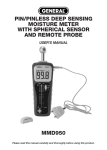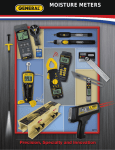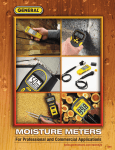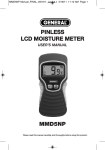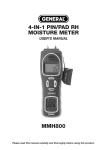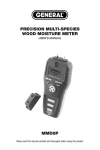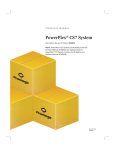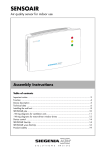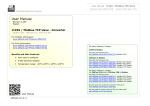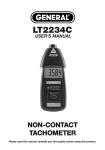Download pin/pinless deep sensing moisture meter with remote probe mmd900
Transcript
PIN/PINLESS DEEP SENSING MOISTURE METER WITH REMOTE PROBE USER’S MANUAL MMD900 Please read this manual carefully and thoroughly before using this product. TABLE OF CONTENTS Introduction . . . . . . . . . . . . . . . . . . . . . . . . . . . . . . . . 3 – 5 Key Features . . . . . . . . . . . . . . . . . . . . . . . . . . . . . . . . . . 5 What’s in the Case . . . . . . . . . . . . . . . . . . . . . . . . . . . . . 6 Product Overview . . . . . . . . . . . . . . . . . . . . . . . . . . . 6 – 7 Setup Instructions . . . . . . . . . . . . . . . . . . . . . . . . . . . . . 7 Install Battery . . . . . . . . . . . . . . . . . . . . . . . . . . . . . . . . 7 Operating Instructions . . . . . . . . . . . . . . . . . . . . . . 8 – 12 Measuring Moisture Levels . . . . . . . . . . . . . . . . 8 – 10 Advanced Setup Instructions . . . . . . . . . . . . . . 10 – 12 Checking Calibration . . . . . . . . . . . . . . . . . . . . . . . . 12 Specifications . . . . . . . . . . . . . . . . . . . . . . . . . . . . . . . . 13 Maintenance Tips . . . . . . . . . . . . . . . . . . . . . . . . . . . . . 13 Warranty Information . . . . . . . . . . . . . . . . . . . . . . . . . . 14 Return for Repair Policy . . . . . . . . . . . . . . . . . . . . . . . 15 2 Thank you for purchasing General Tools & Instruments’ MMD900 Pin/Pinless Deep Sensing Moisture Meter with Remote Probe. Please read this user’s manual carefully and thoroughly before using the meter. The MMD900 is designed for use in woodworking, water damage restoration, building construction and home renovation. Examples include: • Checking for moisture on or below the surface of carpets and sub-flooring • Measuring the surface moisture content of wood, drywall or concrete before painting, wallpapering, sealing or treating • Locating water leaks above ceilings, below floors or behind walls • Selecting dry lumber The meter senses the moisture level of a material using either of two techniques: 1. Inferring the material’s electrical conductivity from the current flow induced between a pair of steel pins placed on or into the material. The wetter a material, the higher its conductivity. The MMD900 is equipped with two pairs of test pins—one pair on the top of the instrument and the other at the end of a cable and remote probe that can fit in tighter spaces. 2. Measuring the change in the material’s capacitance produced by the slight spreading of a local electric field generated by the meter. When the meter is powered on, two plates inside the back of the MMD900’s housing are charged with opposite polarity and pulsed at a high frequency. This causes current to flow, creating a three-dimensional electromagnetic wave at radio frequency that extends about 2 in. (50mm) perpendicular to the meter. When the back of the meter is placed against a wet material, the increased capacitance of the material distorts the wave’s electric field to an extent that can be measured. The distortion—called the fringing field effect—is proportional to the material’s moisture level. WHICH SENSOR SHOULD YOU USE? It depends on the application. The pinless (capacitive) sensor is the only choice for estimating the surface or internal moisture level of materials like finished wood, paint or wallpaper that cannot be marred by pinholes. If accurate readings are important, the pin sensor is the only option because the pinless sensor can only provide relative readings. 3 The distinction between absolute and relative readings is important to understand. The moisture level measurements made by either pair of test pins—on the instrument or on the remote probe—are displayed in units of %WME (Wood Moisture Equivalent) simultaneously on a 0-99.9 count digital LCD and a 40-LED analog bar graph. Pin measurements are accurate within 3% of the reading plus 5 digits. By contrast, readings made by the pinless sensor are simultaneously displayed with no units on the LCD and on a second scale (called REL) of the bar graph. Although the pinless readings have no accuracy specification, they are nonetheless useful for quickly comparing the moisture levels of materials, or the wetness of different areas of the same material. Two possible uses for the relative readings are: 1. Determining whether two pieces of wood to be joined have roughly the same moisture content (which means they will dry out at the same rate without warping). 2. Locating the source of a water leak above a ceiling, by comparing the REL readings at various points on it. If the ceiling is level, the point with the highest REL reading is below the source of the leak. The biggest advantage of the pinless sensor is its ability to sense moisture up to 2 in. below or behind the surface of a material. The stainless steel test pins of the MMD900 can also sense moisture just below the surface of some materials. However, for hard materials like wood or concrete, measurements made by the meter’s test pins mostly represent surface moisture content because: 1) Moisture close to the surface has a greater effect on a reading than moisture deep below it; and 2) The pins of the MMD900 are too short to be driven deep into a hard material. The pins at the top of the meter are 15mm (0.6 in.) long and the pins on the remote probe are 10mm (0.4 in.) long. For softer materials like soil, paper or powders, pin measurements are more likely to reflect the average moisture level of the material between its surface and the penetration depth of the pins (usually far less than 0.6 or 0.4 in.). Other features of the MMD900 include the following: • Any reading (%WME or REL) can be held by pushing a front-panel button. Doing so—called locking or “freezing” the reading—makes it possible to make a measurement in a dark place, hold it, and display it later in a better-lighted area. 4 • The 40-LED analog bar graph groups LEDs of three different colors (green, yellow and red) into low, medium and high moisture bands. Each readout (%WME or REL) can be accompanied by a beeper that can be programmed to sound in different ways in response to different moisture levels or operations. The correlations make it easy to use sight and/or sound to pinpoint areas of peak or relative wetness. The beeper can be disabled without affecting measurements. • An auto power off function that can be triggered by three, five or 10 minutes of inactivity. • The protective cover for the meter’s test pins can be used to manually check the meter’s calibration. Alternatively, the meter can automatically check its calibration each time it is powered on. • A display icon indicates when the meter’s 9V battery is low on charge. KEY FEATURES • Two measurement modes: Pin (conductivity-based) and pinless (based on the fringing field effect) • Two sets of test pins: on top of the meter and at the end of 46 in. remote cable • Pin measurement accuracy of ±3% • Pinless mode measurement depth of 2 in. below surface • Displays %WME and relative readings simultaneously on two displays: 0 to 99.9 count jumbo LCD with 0.9 in. (23mm) digits, and 40-dot tri-color LED bar graph • Manual or automatic calibration checking • Data hold (display lock or “freeze”) function • User-programmable beeper function, backlight function and auto power off time • Low battery warning • Includes two pairs of replacement test pins • Spare pins storage compartment 5 WHAT’S IN THE CASE The MMD900 comes in a custom molded plastic case along with a remote pin-type probe and cable, a 9V battery, two pairs of replacement pins and this user’s manual. PRODUCT OVERVIEW The figure shows all of the controls, indicators and physical features on the front, bottom, top, back and right side of the MMD900. Familiarize yourself with their positions and functions before moving on to the Setup Instructions. B D E A C P F O G H I % WM E 90 70 60 50 40 30 J REL CAL % WM E 85 75 REL 65 B .L . 55 40 SET 30 20 21 18 18 16 15 14 12 9 10 6 8 6 K N 3 0 Se n s e Pin 0 C A L S E T HOLD M L 6 A. Calibration check holes B. Protective cover C. 15mm replaceable test pins D. Indicates display is locked (frozen) E. Measurement mode indicator (REL shown) F. Indicates beeper is enabled G. Indicates battery is weak H. Sensing area (on back of meter) I. Jumbo LCD display J. Five-function Mode button K. Four-function button L. Slots for holding protective cover (on bottom of meter) M. Battery/spare pins compartment cover (on back of meter) N. Tri-color 40-LED analog bar graph O. Remote probe with 10mm test pins (shown with protective cap on) P. Jack for remote probe SETUP INSTRUCTIONS INSTALL BATTERY To open the battery compartment, turn the meter over and lift the tab on the bottom of the battery compartment cover. Remove the cover and set it aside. Then plug the included 9V battery into the wired socket inside the compartment. The terminals of the battery and the socket mate in only one way, with the smaller male terminal plugging into the larger female terminal. Close the battery compartment by replacing its cover and snapping it shut. 7 OPERATING INSTRUCTIONS To power on the meter, press the button and hold it for at least three seconds. (To power off the meter, follow the same instruction.) You can use the meter immediately to measure moisture levels using the factory-set defaults for beeper and backlight operation and auto power off activation time. By default: • The beeper is enabled, and beeps faster the higher the readout above 17%WME in pin measurement mode (17 in REL mode). • The auto power off function is disabled. • The backlight is off. To change the default settings for the beeper, backlight or auto power function, follow the Advanced Setup Instructions beginning on p. 10. At a minimum, General recommends changing the default for the auto power off function to “enabled”. If you leave the auto power off function disabled, you run the risk of discharging the meter’s battery if you forget to power the meter off when you are finished using it. MEASURING MOISTURE LEVELS Surface moisture levels should be measured by the test pins if the surface being tested can tolerate pinholes. If it cannot, use the meter’s pinless sensor. Internal moisture levels can be gauged by the pinless sensor for comparison purposes. The first step in measuring the surface moisture level of a material is to decide whether to use the test pins on top of the meter or the test pins at the end of the remote probe. Choose the remote probe if: • Access to the target surface is limited (for example, if the surface is in close quarters or a corner; the remote probe is slightly narrower than the meter). • You need to make one or more measurements above shoulder height, near floor level, around a corner, or at any angle that makes it hard or impossible to read the display. In situations like these, it’s easier to use the meter by cradling it in your off hand, with the display facing you, while using your dominant hand to position the remote probe. 8 To use the remote probe, remove the small rubber yellow plug from the jack on the right side of the meter (callout P of the figure). Then insert the white plug at the end of the cable into the jack. To make a surface moisture level measurement, press the Mode button as many times as necessary until the text “%WME” appears on the top line of the LCD. Then press the test pins of the meter or the probe against the target material. The material’s surface moisture level will be displayed as a percentage on both the LCD and the LED bar graph. The bar graph uses LEDs of three different colors (green, yellow and red) to indicate different moisture level ranges (low, medium and high, respectively). Readings below 17% are considered low, readings between 17% and 30% medium, and readings above 30% high. If the beeper is enabled with the factory-default setting, it will beep faster the higher the moisture level rises above 17%. To gauge the internal or surface moisture level of a material, enter REL mode by pressing the Mode button as many times as necessary until the text REL appears on the top line of the LCD. To establish a baseline for relative readings, press the area of the back cover marked “Pinless Sensor” against a material known to be completely dry. The meter should read “0” on both the LCD and LED bar graphs. Then press the back of the meter against one or more points on the target surface and compare the readings. Some measurement tips: 1. For best results, press the pinless sensor against a flat area of the target material. 2. When holding the sensor against a material, keep your hand and fingers as far away from the sensing area as possible. 3. The dimensions of the target surface should be at least as large as those of the sensing area: 1.6 x 1.6 in. (40 x 40mm). 4. Never use force to drive the test pins into a hard surface. 5. Measurements of wood are skewed by two variables: ambient humidity and the density of the wood species. The best way to compensate for the effect of these variables is to develop your own moisture level curves, based on your experience working with different species of wood on a day-to-day basis. 9 To scan a material for an area of peak wetness in either measurement mode (%WME or REL), first make sure that the beeper is enabled (indicated by the icon on the top line of the LCD). If the icon is present, scan the material while paying attention to the beeper’s frequency. The faster the beeper beeps, the wetter an area is. Near the high end of the meter’s measurement range, the beeping sounds almost constant. If the beeper has been disabled, to re-enable it you must power off the meter and then change the beeper’s default setting using the Advanced Setup instructions in the next section. To hold a measurement, press the button briefly. The display will “freeze” with the held value, along with a (lock) icon at upper right. To unlock the display, press the button briefly again. ADVANCED SETUP INSTRUCTIONS In Setup mode, you can change the default settings for the meter’s beeper and backlight and auto power off and calibration check functions. To enter Setup mode, power off the meter by pressing the button and holding it for at least three seconds. Then power the meter back on in a special way by simultaneously pressing the and Mode buttons and holding them for at least three seconds. Doing this will cause the beeper to sound, the backlight to come on and the word “SEtUP” to scroll across the LCD. After a few seconds, the LCD will read out “0 = 0”. In this format, the left digit represents the Option No. and the right digit stands for the current setting for that option. For example, “0 = 0” is shorthand for Option 0, Setting 0. 10 The table below details the five function options available to you in Setup mode. Function Option No. Setting Action (Left Digit) (Right Digit) Default Settings Source 0 0 1 Loads factory default settings Loads user’s default settings Backlight comes on for 30 seconds Beeper 1 0 3 Programs beeper to beep faster the higher the moisture level above 17%WME (17 in REL mode) Programs beeper to beep faster the higher the moisture level Programs beeper to sound when switching between measurement modes Disables beeper. Removes icon from display 1 2 Auto power off 2 0 1 2 3 Disables auto power off function Sets auto power off interval to 3 minutes Sets auto power off interval to 5 minutes Sets auto power off interval to 10 minutes Backlight 3 0 1 Disables display backlight Enables display backlight Calibration Check 4 0 1 Enables manual calibration checking by user Programs meter automatically check calibration following power on The factory default setting for all five functions—including the source of the default settings—is 0. To change any or all settings to your choice(s), you must first change the setting of Option 0 from 0 to 1. Opportunities to change the settings of the other four functions from their factory defaults are then made available in order, from Option 0 to Option 4. As each Option is presented, you can change its setting or leave the existing setting unchanged. In either case, you must confirm (save) the setting to allow the sequence to continue. It’s important to understand that in Setup mode you have 30 seconds to confirm the setting of each Option. If you take longer than 30 seconds to confirm any setting, the MMD900 will automatically exit Setup mode and enter Measurement mode. 11 To change any setting, use the Mode button to cycle through the choices (0 or 1 for Options 0, 3 and 4; 0, 1, 2 or 3 for Options 1 and 2). When the setting you want appears as the right digit on the display, press the button to save it. Each time you save a setting, the display advances to the next Option. To leave a setting unchanged, press the button to advance to the next Option. Once a setting has been chosen for Option 4, the meter will automatically exit Setup mode and enter Measurement mode. You cannot access the Options out of sequence. For example, if you have disabled the beeper (by pressing the button with “1 = 3” on the display), you cannot re-enable the beeper without powering off the meter and re-entering Setup mode. The one exception to this rule is the setting of the display backlight. You can turn the backlight on or off by pressing the Mode button and holding it for at least three seconds. CHECKING CALIBRATION Option 4 gives you two choices for checking the calibration of the meter. Choosing Setting 0 lets you check the calibration manually. Setting 1 automatically checks the calibration of the meter each time it is powered on. To check the meter’s calibration manually, press the and Mode buttons at the same time while operating in %WME measurement mode. This will cause the text “CAL” to flash twice on the display and the beeper to sound twice. Remove the protective cap from the top of the meter, taking care not to stab yourself with the two sharp test pins beneath it. Then flip the cap over and place the two holes in its top over the meter’s two test pins. The display should read 40% ±3%. If the calibration check produces a reading higher than 43% or lower than 37%, and the meter is still under warranty, call General's Customer Service Department at 212-431-6100 to arrange to return the meter for service or replacement. 12 SPECIFICATIONS Measurement Ranges Measurement Accuracy Length of Test Pins Length of Remote Cable Measurement Depth (pinless mode) Pinless Sensing Area LCD Range/Size LCD Resolution Bar Graph Composition Bar Graph Resolution Auto Power Off Low Battery Warning Level Current Consumption Calibration Point Operating Temperature Dimensions Weight Power Source 0 to 99.9% WME and 0 to 99 REL ±3% of reading + 5 digits in pin mode 15mm (0.6 in.) on top of meter; 10mm (0.4 in.) on remote probe; 10mm and 15mm (spares) 46 in. (1.168m) 2 in. (51mm) 1.6 x 1.6 in. (40 x 40mm) 99.9 count with 0.9 in. (23mm) high digits 0.1% 40 LEDs of 3 colors: green (0 to17%), yellow (17 to 30%) and red (>30%) ±1 LED (±2.5%) After 3, 5 or 10 minutes (user selectable) with 0% reading <6.5VDC <70mADC 39.4% 32° to 122°F (0° to 50°C) @<80% relative humidity 9 x 2.75 x 1.625 in. (229 x 70 x 41mm) 8 oz. (249g) 9V battery (included) MAINTENANCE TIPS When the icon appears at the upper left of the LCD, it’s time to replace the 9V battery that powers the meter (although measurements will remain valid for several hours after the icon first appears). To replace the battery, follow the Setup Instructions on p. 7. When the tips of the meter’s factory-installed 15mm test pins, or the tips of the 10mm factory-installed test pins on the remote probe show signs of wear, replace them with a pair of 10mm or 15mm pins included in the case. Remove the battery when storing the meter for an extended period of time. Never drop or disassemble the meter or immerse it in water. 13 WARRANTY INFORMATION General Tools & Instruments’ (General’s) MMD900 Pin/Pinless Deep Sensing Moisture Meter with Remote Probe is warranted to the original purchaser to be free from defects in material and workmanship for a period of one year. Subject to certain restrictions, General will repair or replace this instrument if, after examination, the company determines it to be defective in material or workmanship. This warranty does not apply to damages that General determines to be from an attempted repair by non-authorized personnel or misuse, alterations, normal wear and tear, or accidental damage. The defective unit must be returned to General Tools & Instruments or to a General-authorized service center, freight prepaid and insured. Acceptance of the exclusive repair and replacement remedies described herein is a condition of the contract for purchase of this product. In no event shall General be liable for any incidental, special, consequential or punitive damages, or for any cost, attorneys’ fees, expenses, or losses alleged to be a consequence of any damage due to failure of, or defect in any product including, but not limited to, any claims for loss of profits. 14 RETURN FOR REPAIR POLICY Every effort has been made to provide you with a reliable product of superior quality. However, in the event your instrument requires repair, please contact our Customer Service to obtain an RGA (Return Goods Authorization) number before forwarding the unit via prepaid freight to the attention of our Service Center at this address: General Tools & Instruments 80 White Street New York, NY 10013 212-431-6100 Remember to include a copy of your proof of purchase, your return address, and your phone number and/or e-mail address. 15 GENERAL TOOLS & INSTRUMENTS 80 White Street New York, NY 10013-3567 PHONE (212) 431-6100 FAX (212) 431-6499 TOLL FREE (800) 697-8665 e-mail: [email protected] www.generaltools.com MMD900 User’s Manual Specifications subject to change without notice ©2011 GENERAL TOOLS & INSTRUMENTS NOTICE - WE ARE NOT RESPONSIBLE FOR TYPOGRAPHICAL ERRORS. MAN#MMD900 7/26/2011
















